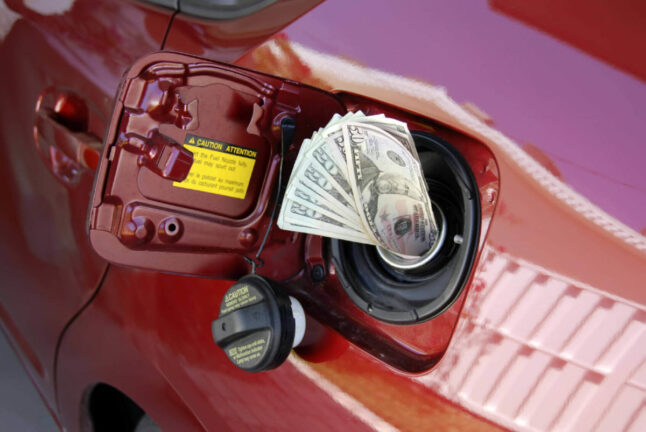High gas prices and high APR could mean that co-branded gas credit cards aren’t a smart payment option.

Gas cards can be a really great value when used correctly, but a new report in Forbes finds that most cardholders are spending more than they’re earning. Experts say that rising gas prices mean more consumers will be likely to carry balances over a month to month. Gas prices have already hit $3 in most parts of the country and may top $4 before the end of the summer. That means high transportation costs for American families. And if you put those costs on credit, you may not pay the balance off every month.
At the same time, credit card interest rates are on the rise, too. The Federal Reserve has already raised its benchmark rate several times and they’re expected to do so again. Every time the Fed rate increases, so do the interest rates on most credit cards. Reward credit cards tend to have a higher APR than other general-purpose credit cards. But experts say APR on gas cards is much higher than even other types of reward cards.
Average gas card APR
| Gas card | APR |
|---|---|
| Chevron | 28.49% |
| CITGO | 28.49% |
| ExxonMobil | 26.49% |
| Shell | 26.49% |
| BP | 28.49% |
The average APR for a general-purpose credit card with no rewards just hit a record high of 16.83% at the end of June. Reward credit cards have an average APR of 16.9%, but that’s still almost 10% lower than most gas cards.
“Such high-interest rates mean these types of credit cards are only good if you’re an expert at managing the debt,” says Gary Herman, President of Consolidated Credit. “If you pay your balances in full every month to avoid interest charges, then gas cards may still be a good value. But for everyone else, the cost is generally higher than the rewards you earn now in 2018.”
How to use gas cards interest-free
According to the American Bankers Association, 44% of credit users are “revolvers.” Revolver refers to a card user that carries at least one credit card balance each month. This is opposed to “transactors,” who are cardholders that pay off their balances in full each month.
“Revolvers pay to use credit cards by shelling out money to cover accrued interest charges each month,” Herman explains. “Interest charges are how a credit card company makes money – that’s their revenue. By contrast, transactors pay off their transactions every billing cycle. As a result, they can use credit card interest-free.”
Herman says that with such high-interest rates, you really only want to use gas cards if you’re a transactor. You must start and end each billing cycle with a zero balance to avoid interest charges. Some cards offer a grace period, which is a certain amount of time after the payment due date before interest charges apply. Not all credit cards have a grace period – check your credit card agreement to see if your cards do. But if you pay the balance in full by the due date, you can avoid interest charges even on cards without any grace period.
The cost of being a revolver with gas cards
Let’s say you have an economy vehicle with a 12-gallon tank. You fill up every week. With gas prices currently around $3, that means you spend about $36 every time you fill-up. Multiply that by four weeks and you spend about $144 per month on gas.
You put these charges on a gas card that has 28% APR and a minimum payment schedule of 2.5% of your balance. The lowest minimum payment is $15.
Now, if you only make the minimum payment on the gas card, you spend $15 each month. But one-third or more of each payment goes to cover accrued interest charges. What’s more, you’re only paying off a small percentage of what you charge each month. So, your balance increases over time. The higher it gets, the more you pay interest charges.
Here’s the breakdown of the math:
- In the first month you have this gas card, you charge $144
- You pay the $15 minimum payment.
- Out of that amount, $3.36 goes to cover interest charges.
- You pay off $11.64 of your balance
- But then the next month you charge another $144
- So, your balance at the end of the second month is $276.36.
- Now when you pay the $15, $6.45 goes to pay off accrued interest charges.
- You pay off $8.55 of what you’ve charged, dropping your balance to $267.81
- By the end of the third month with another round of charges, your balance is up to $411.81
- Now interest charges take up $9.61 and you only pay off $5.39 of principal with your $15 payment.
Minimum payments and reward credit cards don’t mix
“Minimum payments are usually a slow descent into debt problems,” Herman says. “As your balances go up, that high APR means more and more of each minimum payment is used to cover the interest.”
Herman also says you need to keep in mind that the rewards you earn on gas cards are quickly offset by interest charges. Usually, within 1-2 billing cycles of carrying a balance, you’ve cancelled out the miles you earned or the cashback you saved.
“Transactors get a great value out of reward credit cards and gas cards because they don’t pay interest charges,” Herman concludes. “But if you’re using reward credit cards, and particularly high APR gas cards any other way, you may not be getting as much benefit as you believe.”
Have you run into trouble with debt from overusing reward credit cards and gas cards? We can help. Talk to a certified credit counselor today.
